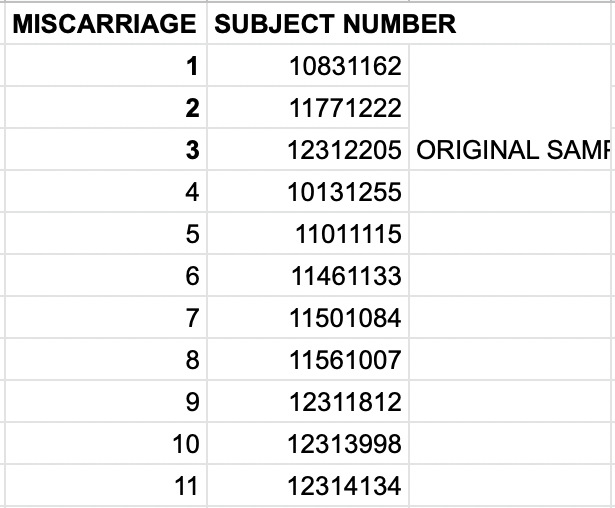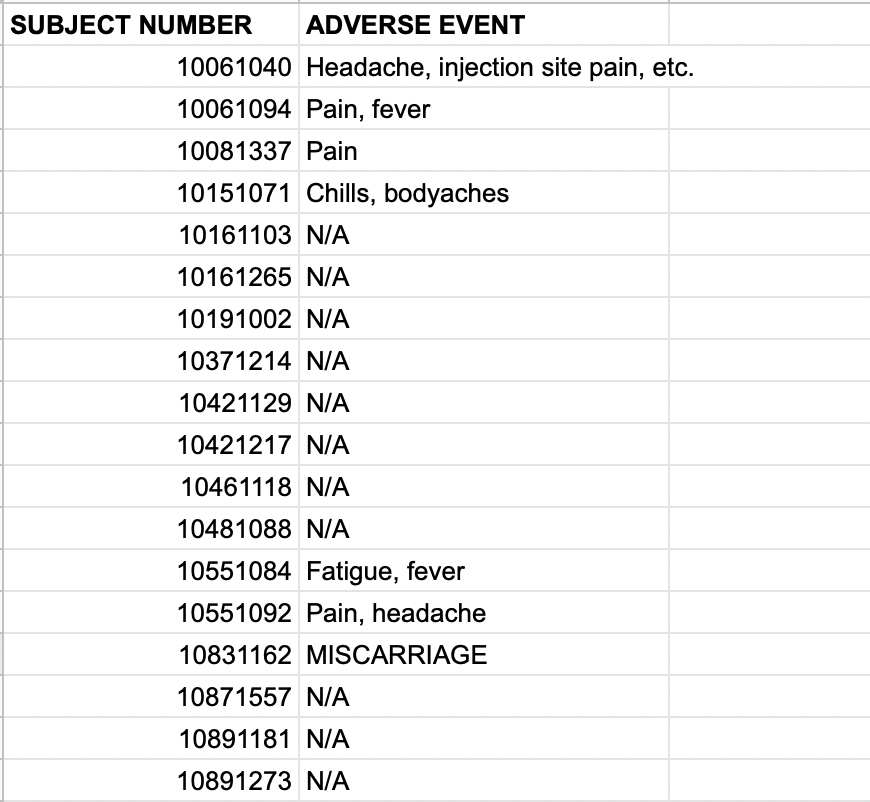Feminist author “Dr.” Naomi Wolf is making the rounds with a bombastic new claim that nearly half of pregnant women in a Pfizer vaccine trial miscarried. It’s not true.
Several media outlets have touted Wolf and her analysis, with her blog being shared all over social media. The doctor (of English literature) claims she has 2,500 volunteers and hundreds of lawyers combing recently released Pfizer documents. This makes it even more astounding that they so wildly misinterpreted the data available to them.
Wolf’s egregious claims center on the document linked here — a report of adverse effects in subjects who took the Pfizer vaccines prior to March 2021. Before we get into the miscarriage data, it’s important to note that any “adverse events” cannot be confirmed to have been caused by the vaccine. For example, some “adverse events” include that vaccine subjects were involved in motor vehicle accidents, crashed a bike or had a fall that led to bruising.
Now: Wolf claims that the aforementioned document finds that twenty-two out of fifty pregnant women in the trial suffered miscarriages, or 44 percent. This is pretty easy to disprove immediately.
Each “adverse event” is linked to a “subject”; each subject in the document is identified by a unique number. If you note the unique subject number related to each miscarriage listed, you will find that each miscarriage is actually listed twice in the document. Why? There are two separate sections: one for all adverse events, and one for adverse events that are considered serious. Naturally, each miscarriage is listed under each section because it’s a serious adverse effect.
For example, take Subject Number 10831162, a white thirty-year-old pregnant woman who got two jabs. Here “miscarriage” is listed under the all adverse events section here:

Her miscarriage is then listed again under the serious adverse events section:

Again, each miscarriage appears twice in the document. I listed each unique miscarriage in my own spreadsheet and confirmed that there were only eleven miscarriages in total.

Now, you might therefore assume that eleven out of fifty pregnant women had a miscarriage after taking the vaccine. This would put the percentage of miscarriages at 22 percent rather than Wolf’s 44 percent. This would be high— as many as 26 percent of all pregnancies end in miscarriage, but only about 10 to 15 percent of known pregnancies do. But this number is not correct either.
We cannot use the fifty pregnant women listed at the bottom of the document as our denominator. Why? Only three of them had miscarriages. I looked up the unique subject numbers of each of the fifty pregnant women in the adverse events section and wrote down what they reported. The vast majority had no reactions or mild reactions: pain at the injection site, fever, headache, etc. Again, only three of them reported having a miscarriage.

P.S. It turns out that pregnancy itself was listed as an “adverse event” by Pfizer, which is why many of the entries have “N/A”.
So who accounts for the other eight miscarriages? We can’t be sure, because there is no full subject list in this set of documents. All we know is that their unique subject numbers do not appear in the table of fifty women who reported being pregnant after taking one dose of the vaccine. Maybe there were others who were pregnant prior to taking the first dose not represented in that table.
The best we can do for now — and this is imperfect — is count up the total number of subjects under “adverse events” who reported “exposure during pregnancy.” Another researcher determined that there are sixty-six subjects who met this criteria. If we divide the eleven miscarriages by the possible sixty-six pregnant women, we get would get 16.67 percent of women in the sample miscarrying after taking the vaccine. That 16.67 percent is slightly above the accepted average of 10-15 percent of known pregnancies that end in miscarriage — but given the small sample size, is well within the margin of error.
Phil Kerpen, who also went through the research like I did, may have identified a twelfth miscarriage that was labeled as “retained products of conception”. This would put the average at 18.18 percent, which is still not outside the margin of error. The percentage could be lower still if there were more pregnant women sampled that, for whatever reason, did not appear in this specific data table.
With all of that being said, this data is not super helpful anyway because the sample size is so small. Sixty-six women is simply not a lot when talking about a vaccine administered to hundreds of millions. But we do know for sure that Wolf and her team majorly misread the data that is available to us here.
I am not a shill for Pfizer. I reached out to them about this data set and received a copy and pasted PR response about how the vaccines are totally safe. I asked to follow-up with a researcher who could tell me exactly how many pregnant women are represented in this sample (Sixty-six? More?) and did not get a response.
I have said I don’t think young and healthy people particularly need to get the vaccine, I am skeptical that we can know the full extent of adverse effects from the vaccine in just a year or two of sampling — and I am strictly against mandates. I personally would opt not to get the vaccine if I were pregnant. However, if we’re going to talk about this very important topic, we need to get our facts right.
The website where Wolf is hosting her “research” has issued a correction about the claim. It notes that two researchers “reviewed this Pfizer document and reached different totals and percentages than did the author of this report.” Make it three, I suppose.
Unfortunately, Wolf has proven to be an untrustworthy source. This is not the first time she has gotten something so wildly wrong. Her book was delayed in 2019 because she misinterpreted data and claimed the Victorians executed a bunch of gay men for sodomy.
Best be cautious with any future claims about vaccines from this one.

























